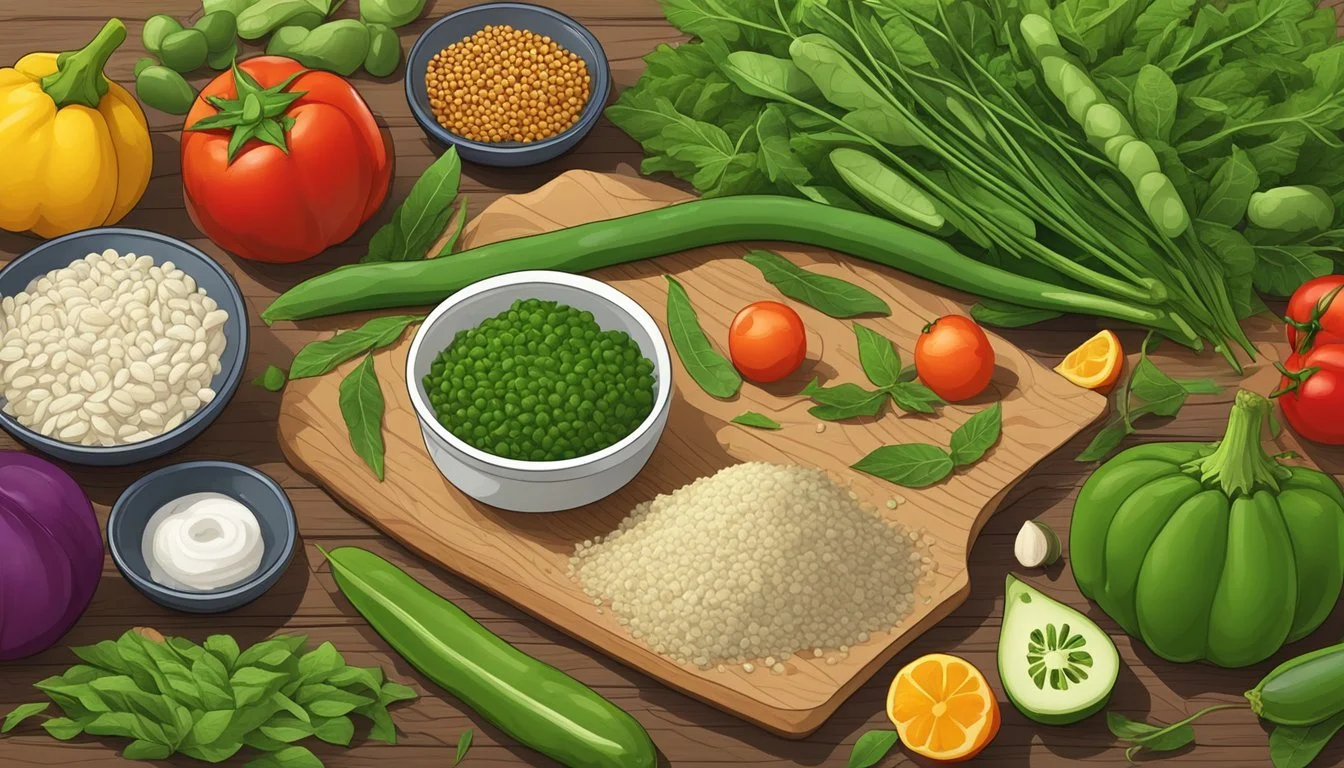Mangetout Substitutes
Best Alternatives for Cooking
Finding a suitable substitute for mangetout, also known as snow peas or pisum sativum var. saccharatum, can ensure that your recipes remain just as delightful and nutritious. As a member of the legume family, mangetout is cherished for its mild flavor and delicate crunch. This versatile vegetable can be enjoyed raw or cooked, making it a valuable addition to various dishes.
If you're searching for an alternative with a similar sweet, slightly grassy taste, sugar snap peas are an excellent choice. They share the same crisp texture and appealing flavor, making them a perfect swap in recipes. Peas, particularly garden peas, can also step in as a mangetout substitute, providing a comparable taste with a bit more plumpness.
For those who prefer a more unique twist, consider using sliced green beans or asparagus tips. Both offer a satisfying texture and can blend seamlessly into stir-fries, salads, and side dishes. By exploring these options, cooks can maintain the nutritional value and taste of their meals even when mangetout isn't available.
Nutritional Profile of Mangetout
Mangetout, also known as snow peas, are a nutritious legume that offer a variety of vitamins and minerals. They are low in calories and have a balanced macronutrient profile, making them a healthy addition to many meals.
Vitamins and Minerals Content
Mangetout is rich in several essential vitamins and minerals.
Vitamin C is particularly abundant, contributing to immune function and skin health. These peas also contain substantial amounts of Vitamin A, which supports vision and immune function, and Vitamin K, important for blood clotting and bone health.
In addition, mangetout provides folate, crucial for DNA synthesis and cell division, and potassium, which aids in maintaining healthy blood pressure levels.
Together, these nutrients make mangetout a beneficial choice for maintaining overall health.
Macronutrients in Mangetout
From a macronutrient perspective, mangetout contains a balanced mix.
They are low in calories, making them suitable for weight management. They provide a modest amount of protein, which is essential for muscle repair and growth.
While low in fats, they are a good source of dietary fiber, aiding in digestive health and maintaining a healthy gut.
These peas also contain carbohydrates, primarily from fiber, which help regulate blood sugar levels. This balanced macronutrient profile makes mangetout a valuable component of a nutritious diet.
Selecting and Preparing Mangetout
Choosing and preparing mangetout correctly ensures maximum flavor and texture. Freshness, proper cleaning, and trimming are essential steps to maintain their sweet, crunchy profile.
How to Choose Fresh Mangetout
When selecting mangetout, freshness is key. Look for pods that are bright green, free of blemishes, and firm to the touch. Avoid any with brown spots or signs of wilting. The pods should snap easily when bent, indicating their crispiness.
Also, pick ones that are uniform in size for even cooking. Smaller pods often have a sweeter taste and more tender texture. Ensuring peak freshness will enhance both the flavor and nutritional value of the dish.
Cleaning and Trimming Practices
Start by thoroughly washing the mangetout under cold running water to remove any dirt or residue. Gently scrub them with your hands to ensure they are clean. After washing, use a paper towel or kitchen cloth to pat them dry.
To trim, top and tail the pods, removing the ends with a sharp knife. Some prefer to remove the string along the sides, which can be done by snapping the tip and pulling the string down the length of the pod. Proper trimming helps maintain the crunchy texture and sweet flavor during cooking.
Cooking Techniques for Mangetout
Mangetout can be prepared using various cooking methods, each bringing out unique flavors and textures. This section explores stir-frying, boiling and blanching, and sautéing to help you cook mangetout to perfection.
Stir-Frying with Mangetout
Stir-frying is a quick and efficient way to cook mangetout while preserving its bright green color and crunchy texture. To start, heat a wok or a large skillet over medium-high heat and add a small amount of oil like vegetable or sesame oil.
Add aromatics such as garlic or ginger for extra flavor. Once the oil is hot, toss in the mangetout and stir-fry for 2-3 minutes. The pods should remain tender-crisp. They can be combined with other vegetables like green beans or proteins like chicken or shrimp for a simple and tasty meal.
Boiling and Blanching
Boiling and blanching mangetout is ideal for preserving their fresh taste and vibrant green color. Bring a large pot of salted water to a boil. Add the mangetout and cook for about 60 seconds, then remove them using a slotted spoon.
If they need more cooking, continue to boil for another 30 seconds. Plunge the mangetout into ice water immediately after boiling to stop the cooking process and maintain their color. This method is excellent for preparing mangetout to be used in salads or added to stir-fries at the last moment.
Sautéing Mangetout
Sautéing mangetout involves cooking them quickly in a pan with a small amount of butter or oil. Heat the pan over medium heat and add the butter or oil. Once melted and hot, add the mangetout to the pan.
Sauté for about 2-3 minutes, ensuring they are evenly coated and cooked through. For added flavor, sprinkle in some fresh herbs like thyme or parsley. This technique produces a slightly caramelized, still crunchy texture, perfect for a side dish or topping for other recipes.
Mangetout in International Cuisine
Mangetout, also known as snow peas or Chinese pea, is a versatile ingredient found in various global dishes. Below, we explore its role in Asian dishes and Western salads, highlighting its unique uses and preparation methods.
Mangetout in Asian Dishes
In Asian cuisine, mangetout is a staple ingredient, especially in stir-fries and soups. Its crisp texture and mild flavor make it a perfect complement to a variety of dishes. Chinese cuisine often features mangetout in stir-fries with ingredients like garlic, ginger, and soy sauce. These stir-fries are quick and easy to prepare, usually involving just a few minutes of cooking to retain the vegetable's bright green color and crunchy texture.
Japanese cuisine integrates mangetout in tempura, where it is lightly battered and fried, offering a contrasting crunch. In Thai cuisine, mangetout is common in stir-fried dishes with a variety of proteins and spices. It can also be found in Vietnamese pho, adding a refreshing crunch to the aromatic broth.
Mangetout in Western Salads
Mangetout adds a crisp texture and subtle sweetness to Western salads. It is often used raw or lightly blanched to maintain its crunchiness. Tossed with ingredients like cherry tomatoes, feta cheese, and olive oil, it brings a fresh dimension to salads.
In Mediterranean recipes, mangetout can be paired with citrus vinaigrettes, olives, and goat cheese. These combinations highlight its versatility and ability to blend well with both bold and subtle flavors. In American cuisine, mangetout often appears in summer salads, mixed with grilled chicken, fresh greens, and a tangy dressing, creating a nutritious and satisfying meal.
Substitutes for Mangetout
Choosing the right substitute for mangetout depends on availability and the specific qualities you want to replicate, such as texture and flavor. Here are the most effective alternatives and how to use them.
Snap Peas and Snow Peas
Snap peas and snow peas are excellent substitutes for mangetout. Both provide a similar crisp texture and sweet flavor. Snow peas, also known as mangetout, have flat pods that can be eaten whole, making them nearly identical in culinary use.
Snap peas, a slightly thicker version, offer a crunchier texture but maintain the sweet, fresh taste. These peas can be used in salads, stir-fries, and as a raw snack. Their interchangeable use with mangetout means you won't need to adjust recipes significantly, making them convenient substitutes.
Viable Vegetable Alternatives
When snap and snow peas are not available, green beans and asparagus are viable substitutes. Green beans offer a similar shape and crunch, although they have a more pronounced flavor. Slice them thinly for use in salads or sautéed dishes.
Asparagus provides a unique, slightly earthy flavor and pairs well with dishes that typically include mangetout. Cut them into similarly sized pieces for a consistent texture. Additionally, vegetables like broccoli and cauliflower, while differing in texture, can provide a satisfying alternative. These vegetables are best when lightly cooked to preserve their crunch.
Utilizing Frozen Varieties
Frozen vegetables can be a convenient substitute if fresh options are unavailable. Frozen snap peas, snow peas, and sugar snap peas retain much of their original texture and flavor when properly thawed.
Blanching frozen vegetables helps in maintaining their bright color and crispness. For the best result, use them in recipes that call for brief cooking times, such as stir-fries and quick sautés. This approach ensures minimal compromise on texture, making frozen varieties a practical and accessible alternative.
Seasoning Complements to Mangetout
Mangetout's crisp texture and mild sweetness pair well with a variety of herbs and spices. Enhancing its flavor can elevate dishes, making them more complex and appealing.
Herbs That Enhance Flavor
Rosemary offers a woody and slightly peppery note that complements mangetout. This herb can be used in stir-fries or roasted vegetable dishes for added depth.
Thyme has a subtle earthy aroma and blends well with mangetout. It’s versatile, perfect for both fresh and dried applications.
Parsley brings a fresh, bright flavor that balances the sweetness of mangetout. It’s often added at the end of cooking to preserve its vibrancy.
Corinader adds a hint of citrus and spice. This herb is particularly effective in Asian-style dishes where its robust profile shines.
Herb Flavor Profile Uses Rosemary Woody, Peppery Stir-fries, Roasted Vegetables Thyme Earthy Fresh, Dried Applications Parsley Fresh, Bright End of Cooking Addition Coriander Citrus, Spice Asian-style Dishes
Spices and Condiments
Cumin has a warm, nutty flavor that pairs well with mangetout, especially in stir-fries or Middle Eastern recipes. It adds a toasty depth that elevates the dish.
Salt is a fundamental seasoning that enhances the natural sweetness of mangetout. A sprinkle of sea salt or kosher salt can make the flavors pop.
Garlic powder or fresh garlic can add a pungent, savory layer, making mangetout more flavorful in simple sautés or complex dishes.
Mushroom powder offers umami and can be a natural complement to mangetout, providing a depth that accentuates its sweetness without overwhelming it.
Mangetout in Health-Conscious Diets
Mangetout, also known as snow peas, are a popular choice in health-conscious diets due to their nutrient-dense profile. They belong to the legume family and offer several health benefits.
Rich in dietary fiber, mangetout aids digestion and promotes a feeling of fullness. This makes them an excellent option for weight management.
One cup of mangetout contains about 128 percent of the vitamin C daily requirements, which supports immune function and skin health.
The low-calorie content of mangetout, just 67 calories per cup, makes them ideal for those looking to maintain a healthy weight without compromising on nutrition.
Incorporating mangetout in diets can contribute to heart health. They contain a good amount of folate, which helps in reducing homocysteine levels, potentially lowering the risk of heart disease.
Their high antioxidant content can also aid in reducing inflammation, which may help in the prevention of certain chronic diseases, including strokes.
To maximize the health benefits, it's best to cook mangetout briefly. This helps in preserving their bright green color and nutritional content.
Given their versatility, mangetout can be easily added to salads, stir-fries, and even soups, enhancing both the nutritional value and flavor of meals.
Culinary Pairings with Mangetout
Mangetout, with its tender texture and subtle sweetness, pairs well with various proteins and side dishes, enhancing both flavor and nutritional value in meals.
Mangetout and Protein
Mangetout complements a variety of proteins. In stir-fries, it pairs well with chicken or prawns. These proteins are quick to cook, maintaining the crispness and green color of the mangetout. Tofu is another excellent option, especially for vegetarian dishes, where it absorbs flavors from seasonings and sauces, blending seamlessly with the mangetout.
In Asian cuisine, mangetout often accompanies beef slices in savory soy-based sauces, offering a contrast between the tender meat and the crunchy pods. Pork can also be paired, especially when cooked with hoisin or teriyaki sauce, accentuating the sweetness of the mangetout.
Accompaniments and Side Dishes
As a side dish, mangetout can be simply blanched or steamed, preserving its vibrant color and crunchy texture. It pairs well with other vegetables like mushrooms and green beans. These vegetables can be sautéed in garlic-infused oil for a flavorful mix.
Noodles and rice dishes also benefit from the addition of mangetout. In recipes like vegetarian mince noodles, the pods provide freshness and a slight sweetness, balancing more robust flavors like hoisin and soy sauce. For a lighter pairing, a simple garlic stir-fry with mangetout and green beans offers a healthy and tasty side.
Salads are another excellent pairing option, where raw or lightly cooked mangetout can add a crunchy element. Mixed with a tangy vinaigrette, it becomes a refreshing accompaniment to meals.









